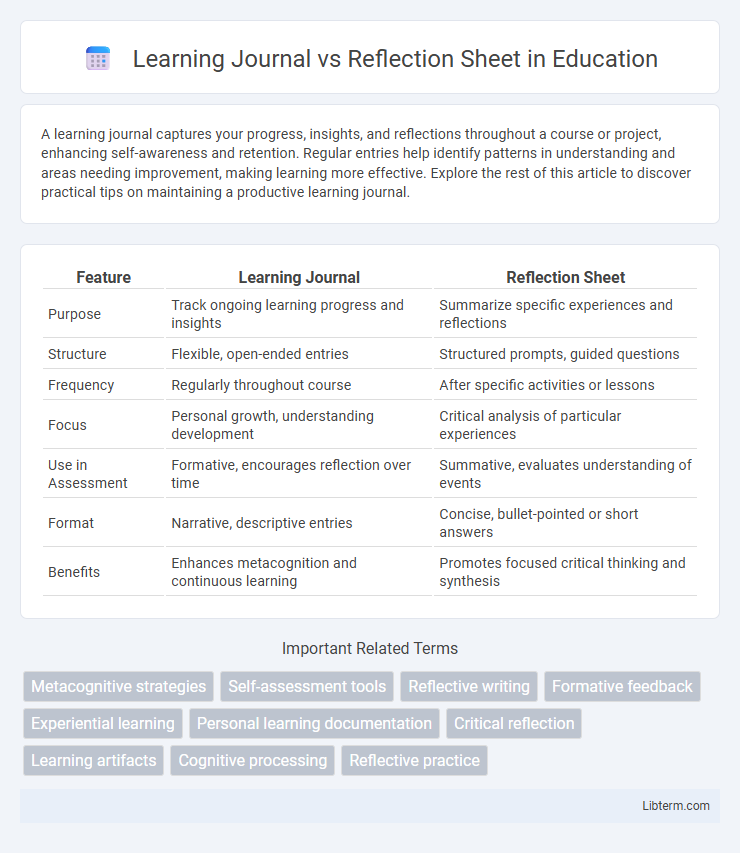A learning journal captures your progress, insights, and reflections throughout a course or project, enhancing self-awareness and retention. Regular entries help identify patterns in understanding and areas needing improvement, making learning more effective. Explore the rest of this article to discover practical tips on maintaining a productive learning journal.
Table of Comparison
| Feature | Learning Journal | Reflection Sheet |
|---|---|---|
| Purpose | Track ongoing learning progress and insights | Summarize specific experiences and reflections |
| Structure | Flexible, open-ended entries | Structured prompts, guided questions |
| Frequency | Regularly throughout course | After specific activities or lessons |
| Focus | Personal growth, understanding development | Critical analysis of particular experiences |
| Use in Assessment | Formative, encourages reflection over time | Summative, evaluates understanding of events |
| Format | Narrative, descriptive entries | Concise, bullet-pointed or short answers |
| Benefits | Enhances metacognition and continuous learning | Promotes focused critical thinking and synthesis |
Introduction to Learning Journals and Reflection Sheets
Learning journals are personal records where learners document their thoughts, progress, and insights throughout a course, fostering continuous self-assessment and growth. Reflection sheets are structured tools designed to guide learners in critically analyzing specific experiences or assignments, enhancing their understanding and ability to apply knowledge. Both tools support metacognitive skills but differ in format and purpose, with learning journals emphasizing ongoing narrative development and reflection sheets focusing on targeted evaluation.
Defining Learning Journals: Purpose and Structure
Learning journals serve as personal records where learners document their experiences, insights, and progress to deepen understanding and enhance critical thinking. Typically structured with dated entries, prompts, or open-ended questions, these journals encourage continuous self-assessment and knowledge integration over time. Their primary purpose is to promote metacognitive awareness by connecting theoretical concepts with practical applications throughout the learning process.
What is a Reflection Sheet? Key Features and Benefits
A reflection sheet is a structured tool designed to encourage critical thinking by prompting individuals to analyze their experiences and learning processes systematically. Key features include guided questions, prompts for self-assessment, and space for personalized insights, which foster deeper understanding and self-awareness. Benefits of using a reflection sheet involve enhanced learning retention, improved problem-solving skills, and the ability to track personal growth over time.
Comparing Formats: Learning Journal vs Reflection Sheet
Learning journals typically involve continuous, detailed entries that capture ongoing thoughts, progress, and emotional responses over time, promoting deeper cognitive processing. Reflection sheets are concise, structured templates designed for summarizing specific experiences or tasks, emphasizing targeted analysis and immediate feedback. The learning journal format supports longitudinal insight and personal growth, while reflection sheets prioritize efficiency and focused evaluation.
When to Use a Learning Journal
Use a learning journal when ongoing self-assessment and deep engagement with course material are needed, allowing learners to track their progress and identify areas for improvement. Learning journals are ideal for capturing evolving thoughts, questions, and insights over an extended period. They support metacognitive strategies, making them effective tools for continuous learning and skill development in both academic and professional settings.
When to Use a Reflection Sheet
A Reflection Sheet is ideal for structured, concise self-assessment after specific tasks or lessons, helping learners quickly identify areas of improvement and knowledge gaps. It is best used in contexts requiring focused, targeted feedback, such as workshops, training sessions, or after completing assignments. Reflection Sheets streamline the evaluation process, making them efficient tools for moments that demand quick, actionable insights.
Benefits of Keeping a Learning Journal
Keeping a learning journal enhances self-awareness by allowing learners to document experiences, thoughts, and progress in a structured manner. This practice promotes deeper cognitive processing, helping to solidify knowledge and track skill development over time. Unlike a reflection sheet, which offers brief insights, a learning journal fosters continuous growth through detailed, personalized entries.
Advantages of Using Reflection Sheets
Reflection sheets promote deeper personal insight by encouraging structured self-assessment and critical thinking about experiences, leading to enhanced learning retention. They provide a concise format that simplifies the documentation of key reflections and actionable goals, which aids in identifying strengths and areas for improvement efficiently. The focused nature of reflection sheets supports consistent habit formation, making them ideal for fostering continuous self-improvement throughout a learning process.
Tips for Effective Reflective Writing
Effective reflective writing in a Learning Journal involves detailed personal insights and connections to learning experiences, enhancing self-awareness and critical thinking. In contrast, a Reflection Sheet requires concise responses focused on key learning points and specific outcomes, promoting clarity and targeted reflection. To optimize both, use clear examples, maintain honest self-assessment, and regularly revisit entries to track progress and deepen understanding.
Choosing the Right Tool for Personal and Academic Growth
Learning journals promote continuous personal and academic development by encouraging regular self-assessment and goal-setting, making them ideal for long-term growth tracking. Reflection sheets focus on specific experiences or assignments, providing targeted insights and immediate feedback to enhance understanding of particular topics. Selecting the right tool depends on whether broad, ongoing self-improvement or focused reflection on discrete events best supports your learning objectives.
Learning Journal Infographic

 libterm.com
libterm.com